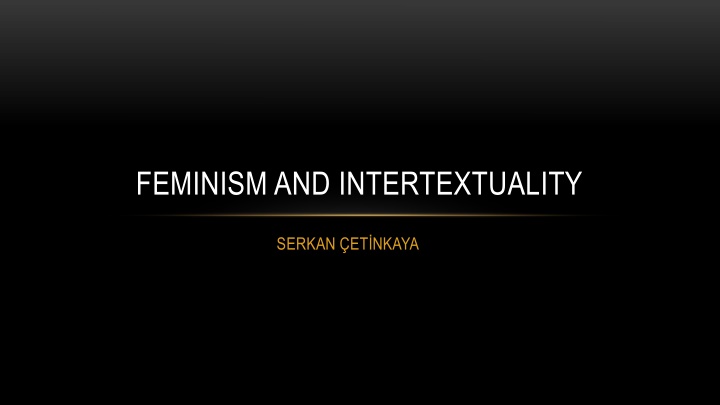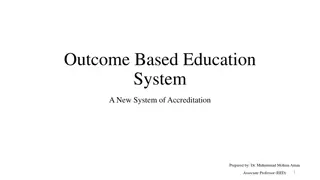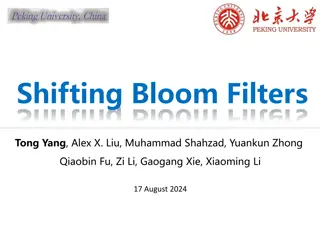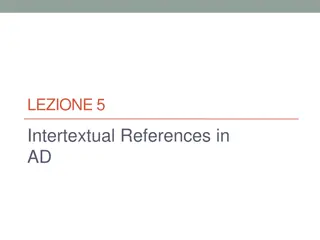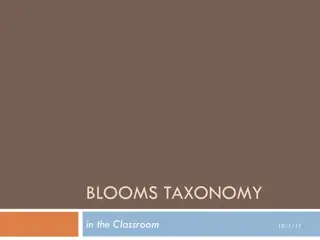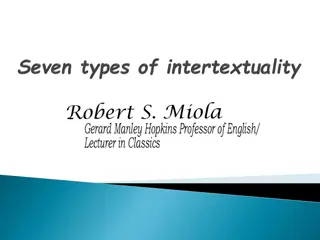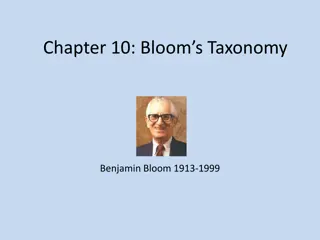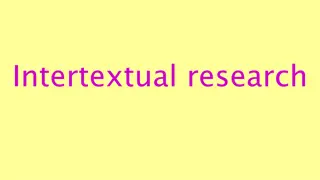Influence of Bloom's Intertextual Theory
Harold Bloom's theory on belatedness in poetry, particularly the influence of Romantic poets like Blake, Wordsworth, Keats, and Shelley, centers around their connection to Milton. Bloom's unique combination of rhetorical and psychoanalytical approaches to intertextuality offers new insights into literary analysis beyond traditional interpretations.
Download Presentation

Please find below an Image/Link to download the presentation.
The content on the website is provided AS IS for your information and personal use only. It may not be sold, licensed, or shared on other websites without obtaining consent from the author.If you encounter any issues during the download, it is possible that the publisher has removed the file from their server.
You are allowed to download the files provided on this website for personal or commercial use, subject to the condition that they are used lawfully. All files are the property of their respective owners.
The content on the website is provided AS IS for your information and personal use only. It may not be sold, licensed, or shared on other websites without obtaining consent from the author.
E N D
Presentation Transcript
FEMINISM AND INTERTEXTUALITY SERKAN ET NKAYA
INFLUENCE AND INTERTEXTUALITY Harold Bloom remains the most conspicuously dedicated to a version of intertextual theory and practice. To understand Bloom s version of intertextual theory we must first turn to his work on Romantic poetry. If Romantic poets such as Blake, Wordsworth, Keats or P. B. Shelley believed so passionately in the idea of the imagination, an idea which ascribes uniqueness of vision to those possessed by or with it, why do they all consistently return, by direct and indirect means, to Milton as a figure of poetic authority? Bloom s answer to the question is expressed neatly by one of his chapter titles: The Belatedness of Strong Poetry (1975a: 63 80).
Belatedness is defined by Bloom as the experience of coming after the event. The reason the Romantic poets could not rid their poetry of explicit or implicit references and allusions to Milton was, it would appear, that they were late for an event. Bloom has no doubt that Milton s poetry is that event, and that Milton s poetry makes all poets after him, including the canonical male Romantics, belated.
Bloom writes of the poetic father as a scandalous figure, scandalous because he cannot die or be murdered. Bloom also employs a Greek vocabulary of precursor (father) and ephebe (son) to figure this relation between Milton and all poets who come after him in the tradition of British poetry.
The combination of a rhetorical and a psychoanalytical approach to intertextuality is Blooms particular contribution to contemporary literary theory s movement beyond the study of literary texts as if they alone contained meaning. For him all texts are inter-texts. There are many similarities between Bloom s approach and that of Riffaterre. Both theorists reduce intertextuality to a model of text and inter-text, and by so doing produce very compelling, reading strategies. However, whilst for Riffaterre such an approach produces interpretive certainty, for Bloom critical reading is itself always a form of misreading
GYNOCRITICISM AND INTERTEXTUALITY Male critics such as Bloom may well believe that there is one singular and inescapable canon of literature, and that this is what causes the anxiety of influence; however, such monologic descriptions of the literary canon evade the fact that women writers have traditionally been excluded from it.
The attempt to examine previously overlooked traditions of writing by women has been a central feature of the feminist critical movement. We get in the gynocritical approach an image of a female literary tradition which depends upon an at least implicit notion of intertextual relations between women writers. In societies in which women are traditionally excluded from serious literature, and even from formal education, the woman writer s anxiety is concerned first and foremost with the culturally dominant images of women which would deny her access to intellectual and aesthetic achievement, which would marginalize her as an angel in the house or as a dangerous other (witch, madwoman, whore).
So according to the Gilbert and Gubar, the nineteenth-century women writers avoided censure for taking up the pen by adopting various strategies in which the gendered images of patriarchal culture are accommodated on the surface level of the work. Taking male pseudonyms, or adopting the persona of what Poovey calls the proper lady , allowed women writers to avoid charges of unnaturalness.
There seems to be, that is, a gender difference in the writers response to affiliations with previous writers. They write: The son of many fathers, today s male writer feels hopelessly belated; the daughter of too few mothers, today s female writer feels that she is helping to create a viable tradition which is at last definitively emerging. (Gilbert and Gubar, 1979: 50)
A woman reader, we might say, would produce a different intertextual reading of Balzacs Sarrasine than would a man. Barthes s homosexual position, some would argue, is clearly evident in his particular reading of that text.
The feminist theorist Toril Moi has written persuasively on the confusions such an approach can create. She argues that gynocritical and other feminist critical approaches frequently confuse the terms female , feminine , and feminist . If female refers to a biological state, then feminine refers to a cultural ideology of womanhood, whilst feminist involves a mode of social and political thought and action. On this basis, to chart previously hidden female literary traditions, is not necessarily a feminist activity.
THE RETURN OF THE FEMALE AUTHOR Nancy K. Miller s work can be placed broadly within the gynocritical approach. Miller argues that it remains important whether texts were written by men or women. Feminist criticism cannot, she argues, locate and describe gender differences within writing if it concentrates not [on] the productions signed by biological woman alone but [on] all productions that put the feminine into play the feminine then being a modality or process accessible to both men and women (Miller, 1988: 72).
We have seen how Kristeva views writing and intertextuality in terms of a tension between phenotext and genotext. Given that the phenotext relates to dominant social discourses and structures, it can be directly related to patriarchy. As the genotext relates to the presocialized relationship between infant and mother, it is a force which seems related to the feminine. Such an opposition, which has been taken up by a host of feminist theorists, views the feminine as a potential, if normally repressed, aspect of language and tends to locate its release not in texts specifically written by women but in avant-garde texts generally.
Miller, however, asserts that the female signature is important, and that approaches such as Kristeva s fall in with a trend within poststructuralism which implicitly collaborates with the effacement of women authors. Such poststructuralist effacement occurs, Miller argues, as part of wholesale rejection of notions of authorship. Poststructuralist theories of language, textuality and intertextuality, Miller argues, deny the feminist critic the site upon which discussion of gender can be produced: that is, the authorial subject.
The postmodernist decision that the Author is Dead and the subject along within him does not ... necessarily hold for women, and prematurely forecloses the question of agency for them. Because women have not had the same historical relation of identity to origin, institution, production that men have had, they have not, I think, (collectively) felt burdened by too much Self, Ego, Cogito, etc. Because the female subject has juridically been excluded from the polis, hence decentered, disoriginated , deinstitutionalized, etc., her relation to integrity and textuality, desire and authority, displays structurally important differences from that universal position. (Miller, 1988: 104)
THE RETURN TO BAKHTIN: FEMINISM AND POSTCOLONIALISM The concept of a woman s text in the wild zone is a playful abstraction: in the reality to which we must address ourselves as critics, women s writing is a double-voiced discourse that always embodies the social, literary, and cultural heritage of both the muted and the dominant. there are muted groups other than women; a dominant structure may determine many muted structures. A black American woman poet, for example, would have her literary identity formed by the dominant (white male) tradition, by a muted women s culture, and by a muted black culture. She would be affected by both sexual and racial politics in a combination unique to her case. (Showalter (ed.), 1986: 263)
Whilst Bakhtin cannot be claimed as a feminist theorist, women and womens writing being conspicuously absent in his work, his concepts of the carnivalesque, of heteroglossia, of double-voiced discourse, and of the dialogic as opposed to the monological principle within language, are of great assistance in articulating the manner in which the othered subject speaks, writes and reads.
